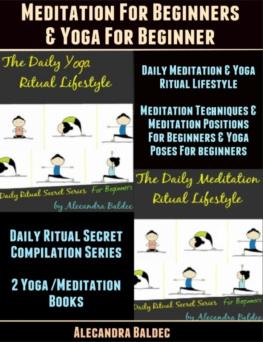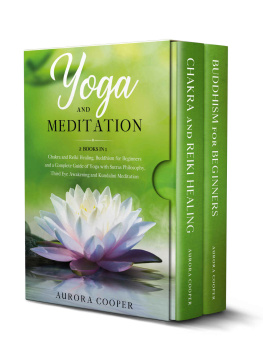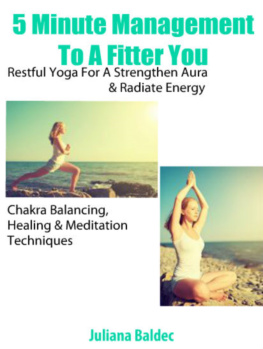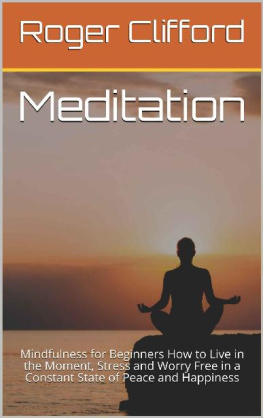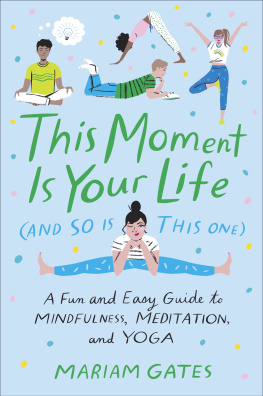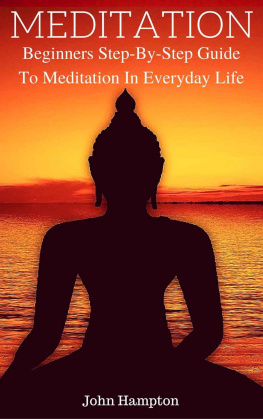Speedy Publishing - Meditation Guide for Beginners Including Yoga Tips (Boxed Set): Meditation and Mindfulness Training
Here you can read online Speedy Publishing - Meditation Guide for Beginners Including Yoga Tips (Boxed Set): Meditation and Mindfulness Training full text of the book (entire story) in english for free. Download pdf and epub, get meaning, cover and reviews about this ebook. year: 2019, publisher: Speedy Publishing LLC, genre: Religion. Description of the work, (preface) as well as reviews are available. Best literature library LitArk.com created for fans of good reading and offers a wide selection of genres:
Romance novel
Science fiction
Adventure
Detective
Science
History
Home and family
Prose
Art
Politics
Computer
Non-fiction
Religion
Business
Children
Humor
Choose a favorite category and find really read worthwhile books. Enjoy immersion in the world of imagination, feel the emotions of the characters or learn something new for yourself, make an fascinating discovery.

- Book:Meditation Guide for Beginners Including Yoga Tips (Boxed Set): Meditation and Mindfulness Training
- Author:
- Publisher:Speedy Publishing LLC
- Genre:
- Year:2019
- Rating:4 / 5
- Favourites:Add to favourites
- Your mark:
- 80
- 1
- 2
- 3
- 4
- 5
Meditation Guide for Beginners Including Yoga Tips (Boxed Set): Meditation and Mindfulness Training: summary, description and annotation
We offer to read an annotation, description, summary or preface (depends on what the author of the book "Meditation Guide for Beginners Including Yoga Tips (Boxed Set): Meditation and Mindfulness Training" wrote himself). If you haven't found the necessary information about the book — write in the comments, we will try to find it.
Speedy Publishing: author's other books
Who wrote Meditation Guide for Beginners Including Yoga Tips (Boxed Set): Meditation and Mindfulness Training? Find out the surname, the name of the author of the book and a list of all author's works by series.
Meditation Guide for Beginners Including Yoga Tips (Boxed Set): Meditation and Mindfulness Training — read online for free the complete book (whole text) full work
Below is the text of the book, divided by pages. System saving the place of the last page read, allows you to conveniently read the book "Meditation Guide for Beginners Including Yoga Tips (Boxed Set): Meditation and Mindfulness Training" online for free, without having to search again every time where you left off. Put a bookmark, and you can go to the page where you finished reading at any time.
Font size:
Interval:
Bookmark:
Table of Contents
Meditation in Action: Learning the Art of Inner Peace
Restore Calm and Free Your Mind with Meditation Techniques
By: John Yates

Chapter 1- What Is Meditation- A Brief History?
Close your eyes and take a deep breath. How do you feel? Chances are you will be focusing on something that you do on a daily basis. Now do it again, only this time, focus all of your energy on your breath. As you begin to focus on your breathing, what do you notice? Your breathing gets deeper the more you concentrate on the act of inhaling and exhaling. This is the first step to meditation.

What is Meditation?
Meditation is the process in which you guide your mind and body into a place of relaxation. People use meditation for a variety of reasons including relaxation, spiritual purposes, and intellectual growth. Meditation is not about concentrating on relaxation, it is the process of awakening your body to a relaxed state of mind. There are varying opinions of the purpose of meditation; while some people meditate by focusing on an idea or subject, others imagine a state of satisfaction or contentment. Both of these reasons for meditating have one common goal.
Meditation is about slowing down the mind as well as the activity of the body. When the mind reaches a particular state of awareness, one is said to have reached a meditative state. One who is practiced in meditation can even achieve a meditative state during an extremely period during the day. Meditation can be defined as a quiet moment in an alert mind. However, this is only the beginning of true meditation. Once someone reaches their highest level of awareness, this is when their full potential can be met.
Many researchers believe meditation can be the greatest solution to relieving stress. Still gaining popularity in West, meditation has been cultivated by Eastern cultures for thousands of years. Eastern cultures have refined meditation to be a technique by aligning mind, body and spirit. Similar methods are now being adapted by Western clinicians and health professionals. Mental health physicians are beginning to notice a difference in patients' behaviors when they try meditation. In a recent study, participants who used meditation reported a better of quality of life, and also had less clinic visits per year.
A Brief History of Meditation
The history of meditation dates back to the ancient times, nearly 5000 years ago. The ancient hunters and gatherers are believed to be the first people to discover meditation by staring into the flames of their campfires. Meditation has evolved throughout thousands of years into the popular form we know today. Some of the earliest forms of meditation can be found in the written records of the Hindus, originating around 1500 BCE.
Considered by some to be the biggest contributor to meditation history, Buddha has been used as the symbol of meditation since 500 B.C. Meditation is believed to have gotten its start in the Asian continent, while other countries caught on later. Each country developed different forms and techniques of practicing meditation. Buddhist and Hindu are two of the most common meditation practices performed today.
As Japanese Buddhism grew in popularity in the 8th century, an interest in meditation began to develop with the people of Japan. It is believed that a Japanese monk who visited China brought his knowledge of meditation that he acquired back home to Japan. As Japan saw a rapid growth in the interest of meditation, people began to modify it to fit individual beliefs and thought processes.
After thousands of years, meditation was introduced to the Western societies. Meditation did not even gain its popularity in the West until the mid-20th century. Sometime during the mid 1960's, researchers began testing the effects of meditation.
The Jewish people had a strong impact on changing the way meditation was done in the Middle Ages and some techniques are still practiced today. This is now referred to as Kabbalistic practices which involve the use of prayer and study. Jewish meditation involves the use of many visualization and spiritual methods, as well as forms of emotional insights.
It was during the Middle Ages that meditation was first used by the Christian faith. In combination with vocal prayer and meditative practices, Christian meditation practices involved the repetition of bible prayer. Around the start of the 19th century, a number of books and articles on meditation started to hit the Western market.
Once a religious technique, meditation has long since been known to help people maintain an emotional balance between mental and physical awareness. It has been used to treat many illnesses including depression, stress, and anxiety. Some people achieve such a sense of relaxation comparable to a good nap. The deep state of relaxation that a meditating person achieves can reduce his or her levels of stress and enables that person to make better decisions. Many people who have meditated report having higher levels of self esteem.
Meditation has been used to help people quit smoking, reduce alcohol consumption, and eliminate drug addictions. Meditation can reduce a person's blood pressure and greatly lower the symptoms of abdominal cramps caused by menopause or chronic pelvic problems. A person who meditates will have a lower heart rate and blood pressure. The process of slowing the breathing down lowers the oxygen needed for the body, and relaxes the muscles.
The history of meditation is rich, going back thousands of years to ancient times. Meditation has been used for spiritual, emotional, and physical relaxation. No matter what your reason for meditating, you too can enjoy the benefits of meditation.
Chapter 2- The Long Term Benefits of Meditation
Life is demanding and the age of the person doesnt seem to matter. The hectic hustle and bustle of managing day-to-day life is stressful and comes with many problems. People who practice meditation experience many positive long-term effects associated with the practice of using meditation.
Improved thought and cognitive function is one of the many long-term benefits of meditation. The human body will eventually shut down for its recuperative processes, and most people recognize the need for this phase. Perhaps its a lack of knowledge, or maybe the individual feels incapable of letting intrusive thoughts go. Regardless of the reason, the brain needs to reboot, yet this is often neglected. Meditation enables one to consciously choose where he or she will focus thoughts instead of following whatever thought or worry that pops into the mind. Someone then learns to choose what, when, and how he or she chooses to think. This makes the person more productive in the long run and more effective as a thinker.
When problem solving, it is not uncommon for individuals to get stuck on the same solution or similar variants of the same solution. Meditation helps thinking develop to the extent that people are more capable and more willing to let go of using the same solution expecting different resolutions. This has implications for situations where this faulty thinking tends to occur such as relationship problems, job problems, and weight loss problems.
Meditation can increase a person's ability to feel sensitivity and compassion for others, so in contentious relationships that often end in failure, the individuals involved could be more open and understanding of the other party. Bosses and employees that practice meditation will also be able to forge better relationships with each other. Parents and children, brothers and sisters, and spouses would all be more in tune with positive communication and positive outcomes for relationships. An individuals ability to identify positive thinking and actions within oneself would make for more productive life choices.
Next pageFont size:
Interval:
Bookmark:
Similar books «Meditation Guide for Beginners Including Yoga Tips (Boxed Set): Meditation and Mindfulness Training»
Look at similar books to Meditation Guide for Beginners Including Yoga Tips (Boxed Set): Meditation and Mindfulness Training. We have selected literature similar in name and meaning in the hope of providing readers with more options to find new, interesting, not yet read works.
Discussion, reviews of the book Meditation Guide for Beginners Including Yoga Tips (Boxed Set): Meditation and Mindfulness Training and just readers' own opinions. Leave your comments, write what you think about the work, its meaning or the main characters. Specify what exactly you liked and what you didn't like, and why you think so.







